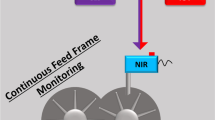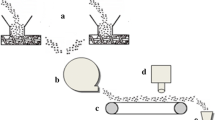Abstract
This article proposes a novel concentration prediction model that requires little training data and is useful for rapid process understanding. Process analytical technology is currently popular, especially in the pharmaceutical industry, for enhancement of process understanding and process control. A calibration-free method, iterative optimization technology (IOT), was proposed to predict pure component concentrations, because calibration methods such as partial least squares, require a large number of training samples, leading to high costs. However, IOT cannot be applied to concentration prediction in non-ideal mixtures because its basic equation is derived from the Beer–Lambert law, which cannot be applied to non-ideal mixtures. We proposed a novel method that realizes prediction of pure component concentrations in mixtures from a small number of training samples, assuming that spectral changes arising from molecular interactions can be expressed as a function of concentration. The proposed method is named IOT with virtual molecular interaction spectra (IOT-VIS) because the method takes spectral change as a virtual spectrum x nonlin,i into account. It was confirmed through the two case studies that the predictive accuracy of IOT-VIS was the highest among existing IOT methods.













Similar content being viewed by others
REFERENCES
Food and Drug Administration, Guidance for Industry Guidance for Industry PAT — A framework for innovative pharmaceutical. 2004;(Sep):19.
Wazade MB. An overview of pharmaceutical process validation and process control variables of tablets. Int J Pharm Sci Res. 2012;3(09):3007–22.
Yu LX. Pharmaceutical quality by design: product and process development, understanding, and control. Pharm Res. 2008;25(4):781–91. doi:10.1007/s11095-007-9511-1.
Simon LL, Pataki H, Marosi G, et al. Assessment of recent process analytical technology (PAT) trends: a multiauthor review. Org Process Res Dev. 2015;19:3–62.
Kiviharju K, Salonen K, Moilanen U, Eerikäinen T. Biomass measurement online: the performance of in situ measurements and software sensors. J Ind Microbiol Biotechnol. 2008;35(7):657–65. doi:10.1007/s10295-008-0346-5.
Roggo Y, Chalus P, Maurer L, Lema-Martinez C, Edmond A, Jent N. A review of near infrared spectroscopy and chemometrics in pharmaceutical technologies. J Pharm Biomed Anal. 2007;44(3 SPEC. ISS):683–700. doi:10.1016/j.jpba.2007.03.023.
Alander JT, Bochko V, Martinkauppi B, Saranwong S, Mantere T. A review of optical nondestructive visual and near-infrared methods for food quality and safety. Int J Spectrosc. 2013;2013:1–36. doi:10.1155/2013/341402.
De Beer TR, Alleso M, Goethals F, et al. Implementation of a process analytical technology system in a freeze-drying process using Raman spectroscopy for in-line process monitoring. Anal Chem. 2007;79(21):7992–8003. doi:10.1021/ac070549h.
DE Beer TRM, Vercruysse P, Burggraeve A, et al. In-line and real-time process monitoring of a freeze drying process using Raman and NIR spectroscopy as complementary process analytical technology (PAT) tools. J Pharm Sci. 2009;98(9):3430–46. doi:10.1002/jps.21633.
Shah RB, Tawakkul MA, Khan MA. Process analytical technology: chemometric analysis of Raman and near infra-red spectroscopic data for predictiong physical properties of extended release matrix tablets. J Pharm Sci. 2007;96(5):1356–65.
De Beer TRM, Bodson C, Dejaegher B, et al. Raman spectroscopy as a process analytical technology (PAT) tool for the in-line monitoring and understanding of a powder blending process. J Pharm Biomed Anal. 2008;48(3):772–9. doi:10.1016/j.jpba.2008.07.023.
De Beer TRM, Baeyens WRG, Ouyang J, Vervaet C, Remon JP. Raman spectroscopy as a process analytical technology tool for the understanding and the quantitative in-line monitoring of the homogenization process of a pharmaceutical suspension. Analyst. 2006;131:1137–44. doi:10.1039/b605299a.
Mantanus J, Rozet E, Van Butsele K, et al. Near infrared and Raman spectroscopy as process analytical technology tools for the manufacturing of silicone-based drug reservoirs. Anal Chim Acta. 2011;699(1):96–106. doi:10.1016/j.aca.2011.05.006.
Widjaja E, Tan YY, Garland M. Application of band-target entropy minimization to on-line Raman monitoring of an organic synthesis. An example of new technology for process analytical technology abstract . Org Process Res Dev. 2007;7:391–5.
Wold S, Sjöström M, Eriksson L. PLS-regression: a basic tool of chemometrics. Chemom Intell Lab Syst. 2001;58(2):109–30. doi:10.1016/S0169-7439(01)00155-1.
Moes JJ, Ruijken MM, Gout E, Frijlink HW, Ugwoke MI. Application of process analytical technology in tablet process development using NIR spectroscopy: blend uniformity, content uniformity and coating thickness measurements. Int J Pharm. 2008;357(1-2):108–18. doi:10.1016/j.ijpharm.2008.01.062.
Hailey PA, Doherty P, Tapsell P, Oliver T, Aldridge PK. Automated system for the on-line monitoring of powder blending processes using near-infrared spectroscopy part I. System development and control. J Pharm Biomed Anal. 1996;14(5):551–9. doi:10.1016/0731-7085(95)01674-0.
Sekulic SS, Ward HW, Brannegan DR, et al. On-line monitoring of powder blend homogeneity by near-infrared spectroscopy. Anal Chem. 1996;68(3):509–13. doi:10.1021/ac950964m.
Sekulic SS, Wakeman J, Phil D, Hailey AP. Automated system for the on-line monitoring of powder blending processes using near-infrared spectroscopy. Part II. Qualitative approaches to blend evaluation. J Pharm Biomed Anal. 1998;17(8):1285–309. doi:10.1016/S0731-7085(98)00025-9.
Blanco M, Gozalez BR, Bertran E. Monitoring powder blending in pharmaceutical processes by use of near infrared spectroscopy. Talanta. 2002;56(1):203–12. doi:10.1016/S0039-9140(01)00559-8.
Momose W, Imai K, Yokota S, Yonemochi E, Terada K. Process analytical technology applied for end-point detection of pharmaceutical blending by combining two calibration-free methods: simultaneously monitoring specific near-infrared peak intensity and moving block standard deviation. Powder Technol. 2011;210(2):122–31. doi:10.1016/j.powtec.2011.03.005.
Jiang J-H, Liang Y, Ozaki Y. Principles and methodologies in self-modeling curve resolution. Chemom Intell Lab Syst. 2004;71(1):1–12. doi:10.1016/j.chemolab.2003.07.002.
Fega KR, Wilcox DS, Ben-Amotz D. Application of Raman multivariate curve resolution to solvation-shell spectroscopy. Appl Spectrosc. 2012;66(3):282–8. doi:10.1366/11-06442.
Maeder M. Evolving factor analysis for the resolution of overlapping chromatographic peaks. Anal Chem. 1987;59(6):527–30. doi:10.1021/Ac00130a035.
Maeder M, Zuberbuehler AD. The resolution of overlapping chromatographic peaks by evolving factor analysis. Anal Chim Acta. 1986;165:287–91. doi:10.1016/S0003-2670(00)85248-4.
Malinowski ER. Window factor analysis: theoretical derivation and application to flow injection analysis data. J Chemom. 1992;6(1):29–40. doi:10.1002/cem.1180060104.
Tauler R. Multivariate curve resolution applied to second order data. Chemom Intell Lab Syst. 1995;30(1):133–46. doi:10.1016/0169-7439(95)00047-X.
Azzouz T, Tauler R. Application of multivariate curve resolution alternating least squares (MCR-ALS) to the quantitative analysis of pharmaceutical and agricultural samples. Talanta. 2008;74(5):1201–10. doi:10.1016/j.talanta.2007.08.024.
Windig W, Liebman SA, Wasserman MB, Snyder AP. Fast self-modeling curve-resolution method for time-resolved mass spectral data. Anal Chem. 1988;60(15):1503–10. doi:10.1021/ac00166a006.
Knorr FJ, Futrell JH. Separation of mass spectra of mixtures by factor analysis. Anal Chem. 1979;51(8):1236–41. doi:10.1021/ac50044a030.
Windig W, Guilment J. Interactive self-modeling mixture analysis. Anal Chem. 1991;63(14):1425–32. doi:10.1021/ac00014a016.
Windig W, Gallagher NB, Shaver JM, Wise BM. A new approach for interactive self-modeling mixture analysis. Chemom Intell Lab Syst. 2005;77(1-2):85–96. doi:10.1016/j.chemolab.2004.06.009.
Muteki K, Blackwood DO, Maranzano B, et al. Mixture component prediction using iterative optimization technology (Calibration-Free/Minimum Approach). Ind Eng Chem Res. 2013;52(35):12258–68. doi:10.1021/ie3034587.
Box GEP, Cox DR. An analysis of transformations. J R Stat Soc Ser B Stat Methodol. 1964;26(2):211–52.
Kaneko H, Muteki K, Funatsu K. Improvement of iterative optimization technology (for process analytical technology calibration-free/minimum approach) with dimensionality reduction and wavelength selection of spectra. Chemom Intell Lab Syst. 2015;147:176–84. doi:10.1016/j.chemolab.2015.08.017.
Bruce SD, Higinbotham J, Marshall I, Beswick PH. An analytical derivation of a popular approximation of the Voigt function for quantification of NMR spectra. J Magn Reson. 2000;142(1):57–63. doi:10.1006/jmre.1999.1911.
Li Q, Wang N, Zhou Q, Sun S, Yu Z. Excess infrared absorption spectroscopy and its applications in the studies of hydrogen bonds in alcohol-containing binary mixtures. Appl Spectrosc. 2008;62(2):166–70. doi:10.1366/000370208783575663.
Koga Y, Sebe F, Minami T, Otake K, Saitow K, Nishikawa K. Spectrum of excess partial molar absorptivity. I. Near infrared spectroscopic study of aqueous acetonitrile and acetone. Phys Chem Chem Phys. 2009;113(35):11928–35. doi:10.1021/jp901934c.
Kaneko H, Arakawa M, Funatsu K. Applicability domains and accuracy of prediction of soft sensor models. AIChE J. 2011;57(6):1506–13. doi:10.1002/aic.12351.
Libnau FO, Kvalheim OM, Christy AA, Toft J. Spectra of water in the near- and mid-infrared region. Vib Spectrosc. 1994;7(3):243–54. doi:10.1016/0924-2031(94)85014-3.
ACKNOWLEDGMENTS
The authors acknowledge the support of the Core Research for Evolutionary Science and Technology (CREST) project “Development of a knowledge-generating platform driven by big data in drug discovery through production processes” of the Japan Science and Technology Agency (JST). The authors wish to thank K. Muteki at Pfizer Inc. for providing actual binary mixture data.
Author information
Authors and Affiliations
Corresponding author
Rights and permissions
About this article
Cite this article
Shibayama, S., Kaneko, H. & Funatsu, K. A Novel Calibration-Minimum Method for Prediction of Mole Fraction in Non-Ideal Mixture. AAPS PharmSciTech 18, 595–604 (2017). https://doi.org/10.1208/s12249-016-0547-6
Received:
Accepted:
Published:
Issue Date:
DOI: https://doi.org/10.1208/s12249-016-0547-6




